1This paper was written with the collaboration of
Mark D. Gross - Planning & Design, University of Colorado
Annette Dula - Women Studies, University of Colorado
In Japan, we have a growing field called 'Information Education,' but people are paying too much attention to computers and the internet. That's why I am proposing unplugging the computer and thinking about the more essential aspects of learning and information design. 'Unplugged' means that technology and multimedia need not be limited to digital forms. Pencil-and-paper and traditional 'by hand' media also have important roles to play.
In the Multimedia Unplugged Workshop, participants use different forms of expression and media, including paper and styrofoam cubes, freeform construction kits and a wide variety of everyday objects, like bamboo leaves and post-it papers. Through this workshop, participants can understand that each medium has its own constraints and opportunities, and have a chance to rethink the roles of multimedia from new perspectives. They can then replug and thus be able to choose appropriate media - digital or physical or both - to express their ideas.
In this paper, I start with the chronological description of the two events of the Multimedia Unplugged Workshop, and then move to focusing on the key concepts which are critical in designing learning environments.
2. Multimedia Unplugged Workshop
The entire Multimedia Unplugged had two main events: design atelier/workshop and exhibition. On February 6 and 7th, 1998, the atelier/workshop was held at the neoMuseum in Yoshino, Nara, Japan.
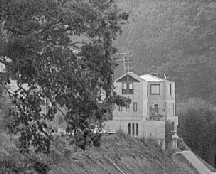
neoMuseum
At this first event, we asked participants to reflect on and express by using various and diverse media-from clay to computers- how they interplay with concepts like Learning, Media, and Design. Specifically, we invited them to consider the special relationships that they-as designers-have with materials and these concepts.
For this workshop we chose Cube as a representation metaphor, and we asked participants to use the cube as a way to think about and project their ideas.
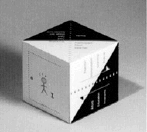
cube
At the second event-the exhibition-atelier participants displayed their work, presenting their cube construction projects to invited guests. They collaborated with and received feedback from an expanded community; and they reflected on what and how they learned by participating in the atelier. The exhibition revealed the participants' understandings of 'learning by design.' It highlighted the opportunities and limitations of using the cube as a metaphor for learning, and it made transparent the role of the self in design.
3. Learning Meets Layered Space
The atelier/exhibit space at the neoMuseum serves as a 'technology of place,' a spatial metaphor for thinking and learning. The downstairs floor is the experience level-a busy place where activity happens. The upstairs balcony is the reflective level, a quieter zone for thinking and metacognition, or "thinking about thinking." As participants enter the atelier space, they are encouraged - by the design of the physical environment - to reflect on their own learning strategies and ways of thinking. The entire atelier/exhibit space is a 7m x 7m x 7m cube.
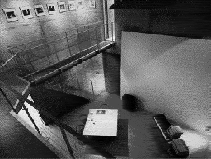
technology of place
4. Learning Meets Tangible Media
Unplugged means that multimedia need not be limited to digital media. Pencil-and-paper and traditional 'by hand' media also have important roles to play in learning. In the Multimedia Unplugged workshop participants use different forms of expression and media, including paper and styrofoam cubes, freeform construction kit 'Toobers and Zots,' and a wide variety of everyday objects, like bamboo leaves, post-it papers, and markers. Designers of future multimedia-understanding that each medium has its own constraints and opportunities-will be able to choose appropriate media-digital or physical or both-to express their message.
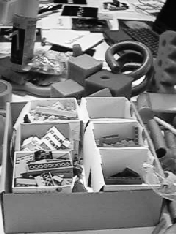
media unplugged
5. Learning Meets Inspirational Concepts
Previously prepared kits are used as opening icebreakers. Each kit contains items of diverse media-objects to think with: oil paints, film, floppy disks, and 'key concept words.' Using the media kits, participants work together to begin their initial exploration of the relationships of media, design, and learning. The media kits encourage dialogue, self-expression, community, and reflection. Participants manipulate the concepts and objects in the media kit to build a collage for display by the end of the workshop, and later at the exhibition.
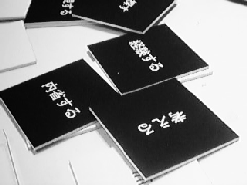 |
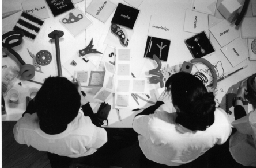 |
| playful words | |
6. Learning Meets Metaphorical Thinking
By the end of the icebreaker, participants are aware of the opportunities as well as the constraints of the design object. They are now ready to begin their individual design project, using the cube as a representation metaphor.
The cube was selected as a simple and highly constrained representation for learning. In the experience level, atelier participants project ideas about relationships of Learning, Media, and Design onto the simple form of a cube. Then they use their cubes to explain and exchange ideas with other participants. Next they reconstruct their cubes, based on what they have learned by interacting with other members of the community.
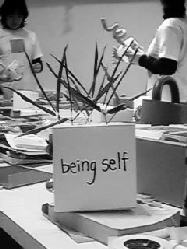
cube reconstructed
7. Learning Meets Social Construction
People learn through experience - learning by doing. We use the cube and media kits to reinforce experiential learning, which has been the cornerstone of our workshops at the neoMuseum. The Multimedia Unplugged Workshop includes spaces for experiential learning. Three kinds of activity take place at the experience level: making and building, community discussion and feedback, and display of results. The atelier also provides three metaphors of space. In the main atelier people make things; in the media caf
 they discuss and get feedback regarding their cubes and their projects; and in the theater they present their ideas and projects after developing them.
they discuss and get feedback regarding their cubes and their projects; and in the theater they present their ideas and projects after developing them.
learning by doing
8. Learning Meets Reflective Experience
Activity with thought can lead to meaningful experiences. Throughout the workshop, participants reflect on what they have been doing. However, a spatial metaphor for thinking about their ideas also exists. The formal place for reflection is the upper level of the neoMuseum. Here participants can take an overview of the activities on the experience level, and reflect on their own work as well as on the work of others. Following Sch
 n's theory of 'reflection in action', reflection takes place at times of breakdown in a complex cognitive process. When participants are at a loss for what to do, they can move both literally and metaphorically to the reflection level and consider their next move.
n's theory of 'reflection in action', reflection takes place at times of breakdown in a complex cognitive process. When participants are at a loss for what to do, they can move both literally and metaphorically to the reflection level and consider their next move.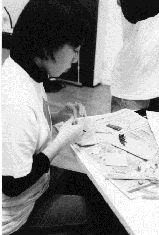
Reflection in action
9. Learning Meets Convivial Community
A primary goal of the atelier/workshop is to bring together a community of learners around the theme 'learning, media, and design'. At the atelier event, they collaborate, communicate, learn, and reflect by being together. They combine the new concepts they have explored with their individual and collective knowledges, experiences, and stories; they weave a tapestry from the colorful threads of their diverse backgrounds and interests. They engage their collective creative potential and their understandings of their environment.
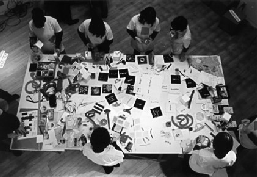
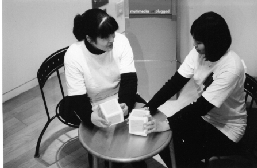
community of talk
10. Learning Meets Virtual Participation
During the atelier/workshop a direct mail (DM) invitation is designed, and copies are printed and sent. Tee-shirt transfers are printed on a color printer, and participants iron the transfers onto tee shirts. They wear the tee shirts during the workshop. Some participants build the Multimedia Unplugged WWW website. Other atelier sites around the world can engage in virtual participation. They contribute their own multimedia images transmitted digitally to the neoMuseum site, where they are reviewed, printed out and posted. Virtual participants also link to the Multimedia Unplugged website. These methods help people learn and understand, and enlarge and enrich the community of learners.
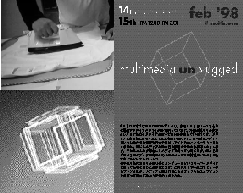
inviting technology
11. Learning Meets Virtual Studio
The World Wide Web offers the possibility for both extending the experience and the reflective levels to a wider community that collaborates through the internet. Designers at the Sundance Laboratory for Computing in Design and Planning at the University of Colorado responded to an invitation to participate in the atelier. They used the internet to send a 'folding and unfolding cube' that was printed out and assembled at the atelier, and they created a website for their contribution that was linked to the main atelier website. The International Media Research Foundation in Tokyo contributed a digital sound responsive cube program (designed by Masahiko Furukata) called 'I wanna be a cube.' The virtual design studio concept offers the opportunity, not only to share design artifacts, but also to comment on projects and ideas.
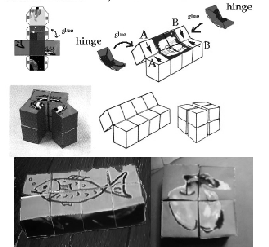
folding and unfolding cube
12. Learning Meets Transformation
We believe in learning as a transformational process. Learning is not only a means to knowledge, but also to understanding one's individual, social, and cultural identity in the world, a way of gaining power and control over one's world. Very little attention is given to this in most learning environments today. However, participants in Multimedia Unplugged gained understanding of their own learning strategies by participating in their own design activities. By creating their own stories through these learning activities, all that took part were greatly empowered!
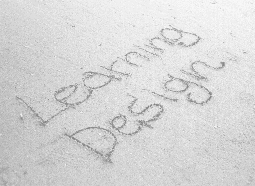
Learning meets information design
13. Books that inspired me:
- Dewey, John. Experience and Education. New York: Collier Books, 1963.
- Friere, Paulo. Pedagogy of the Oppressed (1972). New York: Continuum, 1993.
- Gardner, Howard. Frames of Mind : the theory of multiple intelligences. New York: Basic Books, 1983.
- Norman, Donald A. Things that Make Us Smart: defending human attributes in the age of the machine. Reading, MA: Addison Wesley, 1993.
- Papert, Seymour. The Connected Family. Longstreet Press, 1996.
- Perkins, David. Smart Schools: from training memories to educating minds. New York: Free Press Macmillan, 1993.
- Schn, Donald. The Reflective Practitioner: how professionals think in action. New York: Basic Books, 1983.
- Tufte, Ed. Envisioning Information. Cheshire, CT: Graphics Press, 1990.
14. Acknowledgments
I am thankful to Mark D. Gross and Annette Dula for their collaboration in writing this manuscript. I would also like to thank Multimedia Unplugged Workshop design team Yuri Tsujita, Masahiko Furukata, Hiroko Furukata, Shujun Yoshizaka, Nobuki Ueda, Mitsue Ueda, members of Learning Designs, and the students of Konan Women's University, for making this workshop a convivial and heartful one. A great deal of thanks should also go to my friend Hillel Weintraub who helped me to edit this paper.
Special Thanks to:
Learning Designs, Yoshino, Nara, Japan
Atelier / Exhibition Participants:
kayo kimura














